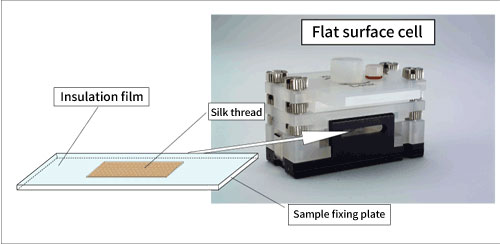Zeta potential on the surface of a fiber
3.Surface of fibrous material and zeta potential
Fibers are usually divided into natural and synthetic fibers. When classified in terms of affinity for water, it is roughly divided into hydrophilic fibers and hydrophobic fibers. It is generally said that natural fibers belong to hydrophilic fibers and synthetic fibers belong to hydrophobic fibers. In addition, fibers can be classified into negative fibers with acidic groups and amphoteric fibers with both acidic and basic groups by distinguishing them from their charged states. Cotton is said to be a negative fiber because it is partially oxidized by bleaching or air oxidation and has a carboxyl group, and all of them show negative electric charge in water. Animal fibers such as wool and silk and synthetic fibers such as nylon are classified as amphoteric fibers and are known to have an isoelectric point because of their acidic and basic groups. Thus, it is very important to measure the zeta potential as differences in the structure or properties of the various fibers are reflected in the surface condition of the fibers in solution.
It is also closely related to fiber hygroscopicity, surface dyeing and cleaning. For example, acid dyes, azo or anthraquinone sulfonic acids or sodium salts of carboxylic acids dye amphoteric fibers well, but do not dye acid fiber cotton. Furthermore, when dyeing, a leveling agent, a dispersion leveling agent, a wet fastness enhancer, etc. are added in order to dye uniformly, with good fastness and reproducibility. Zeta potential of fibers is closely related to the quality of dyes and a lot of research have been done.

Figure 3. Conceptual diagram of surface zeta potential measurement of fibrous and filamentous samples


 Close
Close

